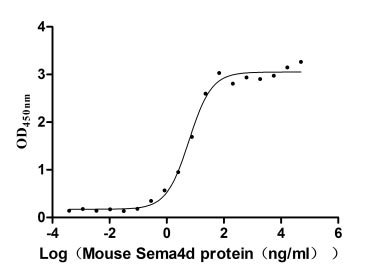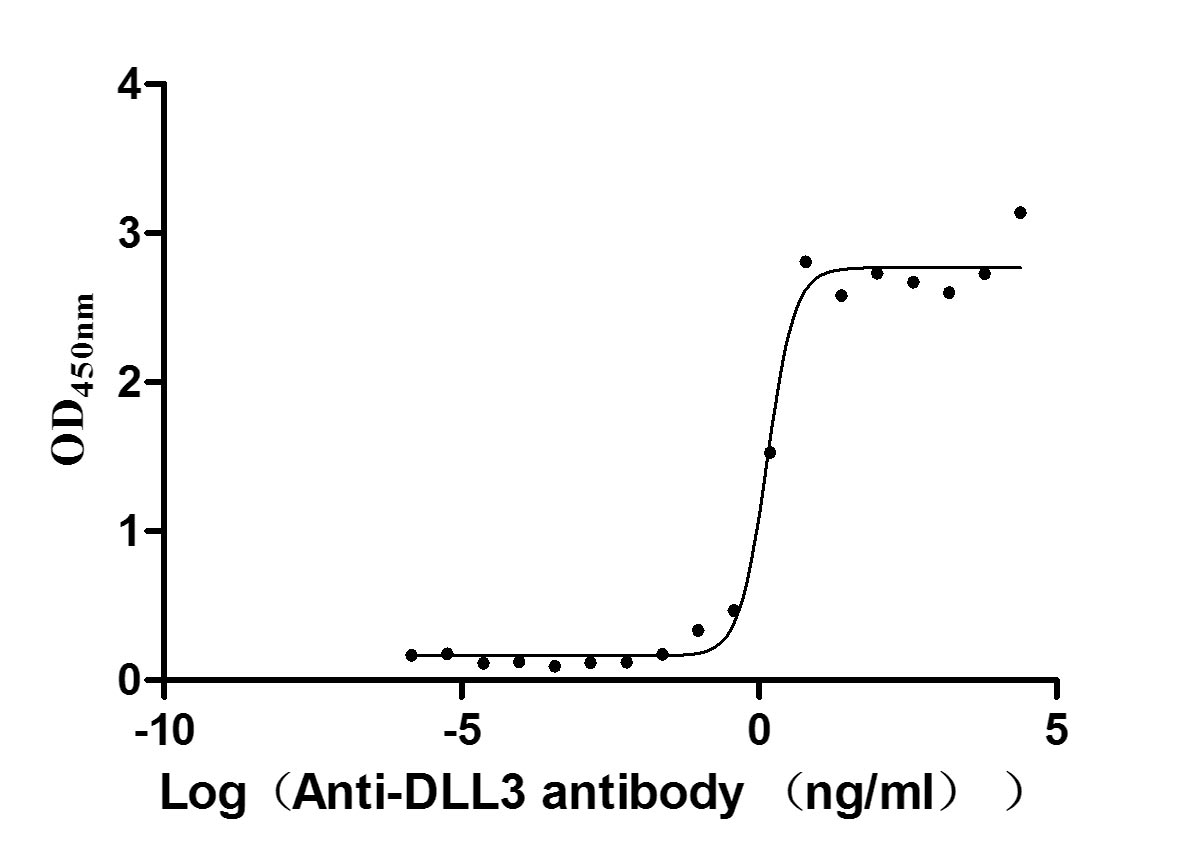Recombinant Human Trace amine-associated receptor 6 (TAAR6), partial
-
中文名称:人TAAR6重组蛋白
-
货号:CSB-YP857018HU1
-
规格:
-
来源:Yeast
-
其他:
-
中文名称:人TAAR6重组蛋白
-
货号:CSB-EP857018HU1
-
规格:
-
来源:E.coli
-
其他:
-
中文名称:人TAAR6重组蛋白
-
货号:CSB-EP857018HU1-B
-
规格:
-
来源:E.coli
-
共轭:Avi-tag Biotinylated
E. coli biotin ligase (BirA) is highly specific in covalently attaching biotin to the 15 amino acid AviTag peptide. This recombinant protein was biotinylated in vivo by AviTag-BirA technology, which method is BriA catalyzes amide linkage between the biotin and the specific lysine of the AviTag.
-
其他:
-
中文名称:人TAAR6重组蛋白
-
货号:CSB-BP857018HU1
-
规格:
-
来源:Baculovirus
-
其他:
-
中文名称:人TAAR6重组蛋白
-
货号:CSB-MP857018HU1
-
规格:
-
来源:Mammalian cell
-
其他:
产品详情
-
纯度:>85% (SDS-PAGE)
-
基因名:
-
Uniprot No.:
-
别名:TAAR6; TA4; TAR4; TRAR4; Trace amine-associated receptor 6; TaR-6; Trace amine receptor 6; Trace amine receptor 4; TaR-4
-
种属:Homo sapiens (Human)
-
蛋白长度:Partial
-
蛋白标签:Tag type will be determined during the manufacturing process.
The tag type will be determined during production process. If you have specified tag type, please tell us and we will develop the specified tag preferentially. -
产品提供形式:Lyophilized powder
Note: We will preferentially ship the format that we have in stock, however, if you have any special requirement for the format, please remark your requirement when placing the order, we will prepare according to your demand. -
复溶:We recommend that this vial be briefly centrifuged prior to opening to bring the contents to the bottom. Please reconstitute protein in deionized sterile water to a concentration of 0.1-1.0 mg/mL.We recommend to add 5-50% of glycerol (final concentration) and aliquot for long-term storage at -20℃/-80℃. Our default final concentration of glycerol is 50%. Customers could use it as reference.
-
储存条件:Store at -20°C/-80°C upon receipt, aliquoting is necessary for mutiple use. Avoid repeated freeze-thaw cycles.
-
保质期:The shelf life is related to many factors, storage state, buffer ingredients, storage temperature and the stability of the protein itself.
Generally, the shelf life of liquid form is 6 months at -20°C/-80°C. The shelf life of lyophilized form is 12 months at -20°C/-80°C. -
货期:Delivery time may differ from different purchasing way or location, please kindly consult your local distributors for specific delivery time.Note: All of our proteins are default shipped with normal blue ice packs, if you request to ship with dry ice, please communicate with us in advance and extra fees will be charged.
-
注意事项:Repeated freezing and thawing is not recommended. Store working aliquots at 4°C for up to one week.
-
Datasheet :Please contact us to get it.
相关产品
靶点详情
-
功能:Orphan receptor. Could be a receptor for trace amines. Trace amines are biogenic amines present in very low levels in mammalian tissues. Although some trace amines have clearly defined roles as neurotransmitters in invertebrates, the extent to which they function as true neurotransmitters in vertebrates has remained speculative. Trace amines are likely to be involved in a variety of physiological functions that have yet to be fully understood.
-
基因功能参考文献:
- Among the 15 SNPs and seven haplotypes of TAAR6, rs7772821 (T>G) on the 3'-UTR showed the strongest correlation with inhaled corticosteroid-induced %DeltaFEV1 in asthmatics. PMID: 25919112
- The results of this study suggested a possible role of TAAR6 in antidepressant response and suicide behavior in patients with depressive disorder PMID: 20493543
- an epistastic effect between a set of TAAR6 and HSP-70 gene variations has a role in major mood disorders PMID: 19582769
- Observational study of gene-disease association, gene-environment interaction, and pharmacogenomic / toxicogenomic. (HuGE Navigator) PMID: 20493543
- Observational study of gene-disease association, gene-environment interaction, and pharmacogenomic / toxicogenomic. (HuGE Navigator) PMID: 19643584
- TRAR4 is preferentially expressed in those brain regions that have been implicated in the pathophysiology of schizophrenia. PMID: 15329799
- Analysis of haplotype blocks revealed no significant association of the TRAR4 region with schizophrenia. PMID: 16189505
- This study strongly support association of the TAAR6 gene with susceptibility to both schizophrenia and bipolar disorder in Korean patients. PMID: 17097106
- The trace amine associate receptor 6 (TAAR6) gene is associated with schizophrenia in the Irish study of high-density schizophrenia families.( PMID: 17505468
- although data do not provide evidence for an altered receptor activity of this TA4 polymorphism, an involvement in bipolar affective disorder cannot be excluded based on our in vitro data PMID: 17895926
- No association of trace amine receptor genes with bipolar disorder. PMID: 17957234
- We reported an association between TAAR6 (trace amine associated receptor 6 gene) variations and schizophrenia (SZ). We now report an association of a set of TAAR6 variations and clinical presentation and outcome in a sample of 240 SZ Korean patients. PMID: 18583103
- Trace amine associated receptor 6 is not important for the development of schizophrenia in our family samples. PMID: 18628684
- Here we demonstrate that TAAR6 is not associated with schizophrenia in the ICCSS sample. PMID: 18973992
- Analysis of epistasis between a set of variations located in the TAAR6 and HSP-70 genes found weak associations with the risk of psychosis and response to antipsychotic treatment PMID: 19643584
- This study provides preliminary evidence that HSP-70 may play a role in the disrupted mechanisms that lead to BPD. PMID: 19766166
- Observational study of gene-disease association, gene-environment interaction, and pharmacogenomic / toxicogenomic. (HuGE Navigator) PMID: 19766166
- Observational study of gene-disease association. (HuGE Navigator) PMID: 19345712
- Observational study of gene-disease association. (HuGE Navigator) PMID: 18973992
- Observational study of gene-disease association. (HuGE Navigator) PMID: 18978678
- Observational study of gene-disease association. (HuGE Navigator) PMID: 18628684
- Observational study of gene-disease association. (HuGE Navigator) PMID: 18583103
- Observational study of gene-disease association. (HuGE Navigator) PMID: 18198266
- Observational study of gene-disease association. (HuGE Navigator) PMID: 16075187
- Observational study of gene-disease association. (HuGE Navigator) PMID: 17097106
- Observational study of gene-disease association. (HuGE Navigator) PMID: 17505468
- Previous studies reported TAAR expression in brain. This paper found TAAR expression only in olfactory epithelial cells and that each TAAR detects a unique set of amine ligands. TAARs seem to function as a family of chemosensory receptors for amines. PMID: 16878137
显示更多
收起更多
-
亚细胞定位:Cell membrane; Multi-pass membrane protein.
-
蛋白家族:G-protein coupled receptor 1 family
-
组织特异性:Expressed at low abundance in various brain tissues, as well as in fetal liver, but not in the cerebellum or placenta. In the brain, comparable levels of expression in basal ganglia, frontal cortex, substantia nigra, amygdala and hippocampus, highest expr
-
数据库链接:
HGNC: 20978
OMIM: 608923
KEGG: hsa:319100
STRING: 9606.ENSP00000275198
UniGene: Hs.434196
Most popular with customers
-
Recombinant Human Transthyretin (TTR) (Active)
Express system: Mammalian cell
Species: Homo sapiens (Human)
-
Recombinant Mouse Semaphorin-4D (Sema4d), partial (Active)
Express system: Mammalian cell
Species: Mus musculus (Mouse)
-
Recombinant Human Delta-like protein 3 (DLL3), partial (Active)
Express system: Mammalian cell
Species: Homo sapiens (Human)
-
Recombinant Human C5a anaphylatoxin chemotactic receptor 1 (C5AR1)-VLPs (Active)
Express system: Mammalian cell
Species: Homo sapiens (Human)
-
Recombinant Human Cannabinoid receptor 1 (CNR1)-VLPs (Active)
Express system: Mammalian cell
Species: Homo sapiens (Human)
-
Recombinant Human Desmoglein-2 (DSG2), partial (Active)
Express system: Mammalian cell
Species: Homo sapiens (Human)
-
Recombinant Human Carcinoembryonic antigen-related cell adhesion molecule 8(CEACAM8) (Active)
Express system: Mammalian cell
Species: Homo sapiens (Human)
-
Recombinant Macaca fascicularis C-type lectin domain family 4 member C(CLEC4C), partial (Active)
Express system: Mammalian cell
Species: Macaca fascicularis (Crab-eating macaque) (Cynomolgus monkey)




















